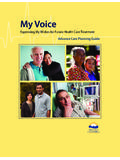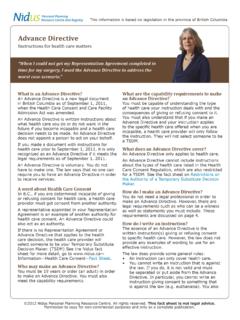Transcription of Guiding Children's Behaviour - British Columbia
1 GuidingChildren s BehaviourBCHealthPlanningFor more information on this or other child care issues,please contact your local health is also a video version of this booklet which is availableat all regional health offices, public libraries,and through child care referral and resource contacts(Ministry of Community, Aboriginal and Women s Services).This booklet may also be viewed on theMinistry of Health Planning website s BehaviourCanadian Cataloguing in Publication DataDeveloped in cooperation with the British Columbia Day Care Action Coalition and theEarly Childhood Educators of Includes bibliographical references: & discipline with young childrenISBN 0 7726 2844 01. Discipline of children British British Columbia . Community Care Facilities Daycare Action Early Childhood Educators of British 1996 09711 C96 960090 9 Table of ContentsIntroduction.
2 1 Guiding children s Behaviour .. Development.. 31. Each Child is a Unique Individual2. children s Behaviour Reflects Their Level of Development3. children s Experience in Their Family and Culture InfluencesTheir Behaviour PatternsB. Environment.. 41. Things2. Space3. People4. Time/Program ScheduleC. Guidance Strategies: Prevention.. 51. Establish Clear, Consistent, and Simple Limits2. Offer Straightforward Explanations for Limits3. State Limits in a Positive Way, Rather Than in a Negative Way4. Focus on the Behaviour , Rather Than on the Child5. State What is Expected, Rather Than Pose Questions6. Provide Choices7. Allow Time for children to Respond to Expectations8. Reinforce Appropriate Behaviour , With Both Words and Gestures9. Ignore Minor Incidents10.
3 Encourage children to Use You as a Resource11. Be Alert12. ProximityD. Guidance Strategies: Intervention.. 91. Gain a Child s Attention in a Respectful Way2. Use Proximity and Touch3. Remind4. Acknowledge Feelings Before Setting Limits5. Redirect or Divert When Appropriate6. Model Problem-Solving Skills7. Offer Appropriate Choices8. Use Natural and Logistical Consequences9. Limit the Use of Equipment10. Provide Opportunities for children to Make AmendsE. Challenging behaviours : Intervention.. 13 RediretionHoldingTime AwaySummary.. 15 Bibliography.. 16 IntroductionThe topic of Guiding children s Behaviour is of interest to a varietyof individuals who care for children . Whether the setting is in aFamily Child Care home, a Preschool, a Group Day Care centre oran Out of School Care environment, an understanding of the basicprinciples and practices related to Guiding children s behaviourserve as a foundation for interacting successfully with booklet promotes strategies and techniques that reinforcerequirements in the Community Care Facility Act and Child CareLicensing Regulation.
4 As described in the Child Care LicensingRegulation, licensed settings are required to have a writtendiscipline booklet provides an overview of the attitudes, knowledgeand skills helpful to parents, caregivers, and professionals in theirday-to-day relationships with children . It introduces two differentstrategies prevention and intervention. It also offers a practicalframework with concrete suggestions and strategies that encourage self-guidance are based on thevalue and belief that children can learn impulse control to help themdevelop self-discipline, responsibility, positive capabilities andattitudes. Guiding children s Behaviour is an ongoing process; it is along-term goal that parents, caregivers and professionals have children s BehaviourDiscipline - a DefinitionWhat do we mean when we say discipline or Guiding children sbehaviour ?
5 Discipline is something adults do with and for children ,rather than to children to stop them from behaving in undesirableways. Guiding children s Behaviour is intended to help childrenbecome self-disciplined as they learn appropriate and acceptablebehaviour patterns. These methods of Guiding Behaviour arecontinuous. Discipline or Guiding children s Behaviour is donewhile appropriate Behaviour is occurring, as well as before, during,and after socially unacceptable Behaviour is there are a wide variety of theories and approaches related toguiding children s Behaviour , the goal remains constant to assistchildren in developing respect, self-control, self-confidence andsensitivity in their interactions with others. Self-discipline requires an understanding of oneself and anawareness of the ways in which one can cope with difficulties,frustrations, and disappointments.
6 Self-discipline affords a personthe inclination to concentrate on a task as long as is necessary tolearn, perfect, or complete it. A. GedrosePurposeThe purpose of this booklet is to offer recommended practices forguidance, which are based on developmentally appropriate childdevelopment. Self-discipline methods are not humiliating tochildren, or to adults. Self-discipline is based on mutual respect andcooperation. These guidelines will assist parents and those workingwith all ages of children and will serve as a reminder for those withtraining and and ConsiderationsChildren s Behaviour is influenced by their overall development,their environment, and the adults who care for them. Adults shouldfirst consider guidance principles based on the following : Child Development1.
7 Each Child is a Unique IndividualBy nature, children differ in terms of their activity level,distractability, and sensitivity. Parents and caregivers who acceptand understand these differences in children s styles will be in abetter position to offer effective and appropriate guidance for children s Behaviour ReflectsTheir Level of DevelopmentWhen adults recognize that growth entails both experimenting andmaking mistakes, and that difficulties are a normal, expected partof children s development, they tend to be more accepting andpatient with socially unacceptable Behaviour . It is important to havereasonable expectations whichare consistent with each child sdevelopmental abilities. Whenadults have an understanding ofappropriate developmentalissues for children , they aremore effective in dealing withthem.
8 Caregivers who take thetime to offer developmentallyappropriate verbal explanationsand guidance help children gainconfidence, competence, and social problem-solving children s Experience in Their Family andCulture Influences Their Behaviour PatternsExpectations for Behaviour vary greatly from family to family, andfrom culture to culture. Some may place a higher value on compliance,dependence, and respect for elders, while others may give priorityto risk-taking, assertiveness, and independence. Knowledge about achild s background and respect for different value systems will helpcaregivers respond sensitively to varying child-rearing summary, adults who appreciate these principles of childdevelopment will develop attitudes and practices which are basedon realistic expectations of children s needs and : EnvironmentThe environment refers to all that surroundsa child.
9 This includes both physical and social ThingsWhen toys and materials are in goodsupply, familiar and developmentally-appropriate, children are encouraged tofocus and become involved in productivelearning experiences. Caregivers who areknowledgeable about the ways in whichenvironments influence Behaviour canplan their settings accordingly. Withgroups of infants and toddlers, providingduplicates of favorite toys is SpaceThe way in which space is used can either encourage or discouragedesired Behaviour . Where space is sufficient, children can play andwork in a relaxed setting. It is important that sufficient space isavailable for the program of activities. Where areas are specificallydesignated for adults or children , and/or for individuals or groups,conflict is minimized.
10 In short, space which is aesthetically pleasing,planned, and organized contributes to an environment which promotesgood mental health and diminishes the potential for People (Adults and children )Adults who are committed to nurturing and Guiding young childrencreate an atmosphere which fosters trust, security, and adult s verbal and physical communications skills are critical inmodelling the Behaviour they wish children to learn. When childrenare in an environment that encourages caring and cooperativerelationships, they learn to relate with each other in positive Time / Program ScheduleSchedules, routines, and transitions serve as a framework fromwhich children gain trust, security, and order. While these can beflexible to some degree, they must provide children with clearguidelines about what is children s needs throughout the day requires that time beappropriately balanced between active and restful periods, individual andgroup activities, and child initiated/adult initiated Guidance Strategies:PreventionThe following strategies are prevention oriented.














